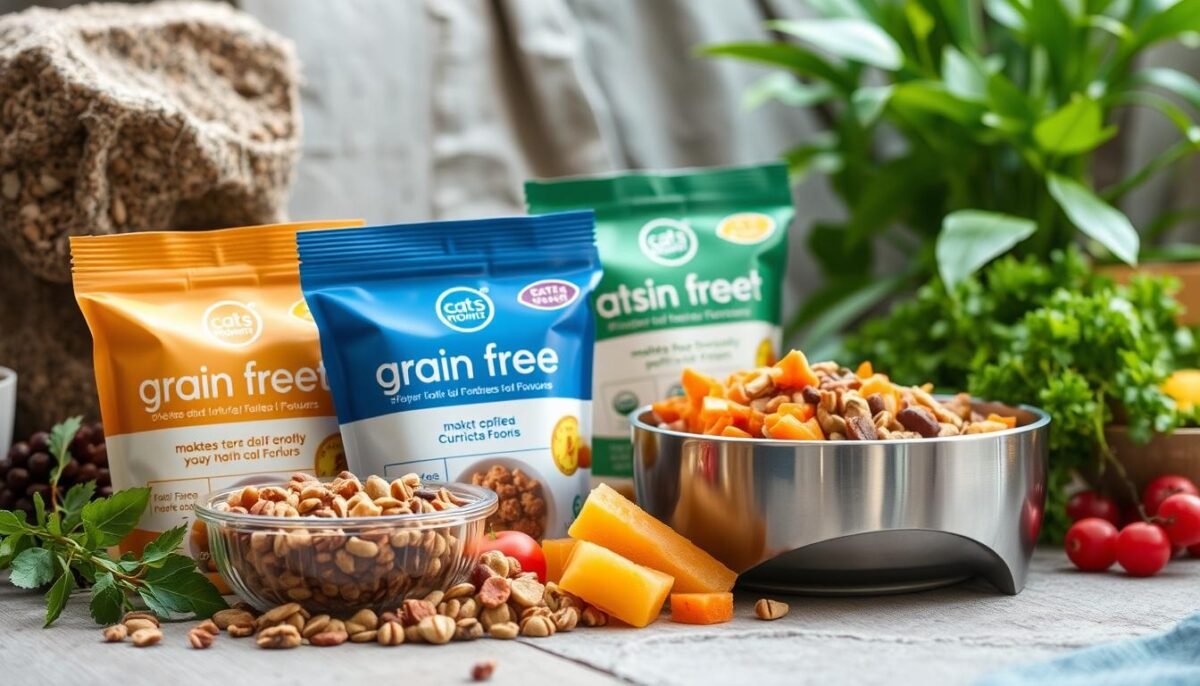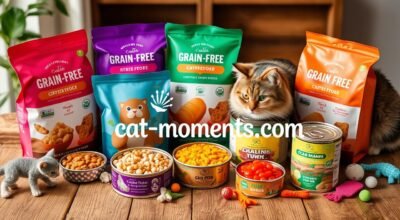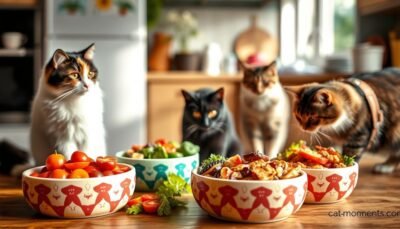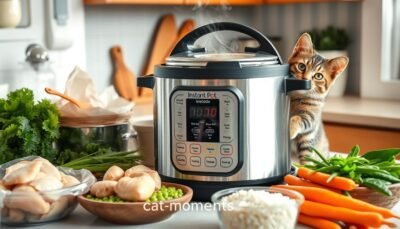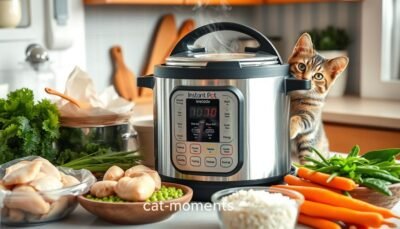Are you looking for the best grain-free cat food for 2024? You’re in the right place! Our guide explores grain free cat food, its benefits, top brands, and key nutrients. We focus on your cat’s health and wellness, showing you how to choose the best high-protein cat meals.
Key Takeaways
- Discover the advantages of a grain-free diet for your cat’s overall well-being.
- Learn about the leading grain free cat food brands and how they compare in terms of quality and price.
- Understand the essential nutrients cats require and the role of feline nutrition in their diet.
- Explore the key ingredients to look for when selecting the right grain-free formula.
- Gain insights on how to successfully transition your cat to a grain-free diet.
Understanding Grain Free Cat Food and Its Benefits
We always want the best for our cats. Grain-free cat food is a popular choice. But what is it, and is it good for your cat?
What is Grain Free Cat Food?
Grain-free cat food doesn’t have grains like wheat or corn. Instead, it uses potatoes or sweet potatoes for energy and fiber.
Why Choose Grain Free for Your Cat?
- It can help with allergies. Grains can cause skin problems and digestive issues in cats.
- It has more protein. This is closer to what cats naturally eat.
- It’s better for digestion. Without grains, cats might have fewer stomach problems.
Common Misconceptions About Grain Free Nutrition
Grain-free diets have their perks, but there are myths. Not all grain-free foods are better. Some have too many carbs. Also, some cats do well on regular food.
Talk to your vet about what’s best for your cat. They might suggest a carbohydrate-free diet, hypoallergenic pet food, or gluten-free pet products.
“A grain-free diet can be an excellent choice for some cats, but it’s not a one-size-fits-all solution. Each cat is unique, and their nutritional needs should be carefully considered.”
Nutritional Requirements for Cats
As pet owners, knowing what our cats need is key. Cats must eat feline nutrition and high-protein cat meals to stay healthy. We’ll look at the nutrients they need, the importance of protein, and why taurine is crucial for their health.
Essential Nutrients Cats Need
Cats have special dietary needs. Their food should be full of quality animal-based proteins, fats, vitamins, and minerals. Here are some key nutrients:
- Protein: Needed for growth, repair, and body maintenance
- Fats: Give energy and help with vitamin absorption
- Carbohydrates: Provide energy, but cats don’t need much
- Vitamins: A, B, C, and D support the body
- Minerals: Calcium, phosphorus, and iron are important for bones and health
The Role of Protein in a Cat’s Diet
Protein is vital for cats. It helps build muscles, organs, and tissues. Cats need more protein-rich foods than other pets because they can’t make some amino acids. Giving them high-protein cat meals is key for their health.
Importance of Taurine for Felines
Taurine is a must for cats. They can’t make enough of it on their own. It’s important for heart health, vision, and brain development. A feline nutrition diet with plenty of taurine is essential for their well-being.
Top Grain Free Cat Food Brands for 2024
Pet owners are now more aware of their cats’ dietary needs. This has led to a big increase in demand for grain-free cat food. In 2024, we’re excited to introduce you to the top brands in grain-free cat food. Each brand offers unique formulas to ensure your cat’s health and happiness.
Overview of Leading Brands
Finding the right grain-free cat food can be hard. But we’ve found the best brands for you. These brands use premium, natural ingredients and innovative formulas. They’re setting the standard for grain-free nutrition.
Brand Comparisons: Quality and Price
Choosing the right grain-free cat food means finding a good balance between quality and price. We’ve looked at the top brands. We compared their ingredients, manufacturing, and prices to help you choose.
| Brand | Protein Source | Non-GMO Ingredients | Price Range (per lb) |
|---|---|---|---|
| Feline Feastings | Chicken, Salmon | Yes | $2.99 – $4.49 |
| Purrfect Paws | Turkey, Lamb | Yes | $3.49 – $5.29 |
| Whisker Delights | Beef, Duck | Yes | $2.79 – $4.19 |
What to Look for in a Brand
When looking at grain-free cat food, watch for key features. Look for non-GMO ingredients, high-quality natural cat treats, and a focus on grain free cat food. These things show a brand cares about your cat’s health.
“At the end of the day, our cats deserve the very best, and that’s what we’re here to provide.” – Felicia Meowington, Founder of Feline Feastings
Key Ingredients to Look for in Grain Free Cat Food
Choosing the right grain-free cat food is key for your cat’s health. Look for important ingredients that support your cat’s well-being. These ingredients are crucial for a grain-free diet that meets your cat’s nutritional needs.
High-Quality Animal Proteins
Cats need a diet rich in high-protein cat meals from animal sources. Look for grain-free cat foods with high-quality animal proteins like chicken, turkey, or fish. These proteins give cats the amino acids and nutrients they need to stay healthy.
Healthy Fats and Their Benefits
Fats are vital in a cat’s diet, providing energy and supporting health. Grain-free cat foods should have healthy fats from fish oil or chicken fat. These fats help keep your cat’s coat shiny, skin healthy, and overall well-being.
The Importance of Fiber Sources
Fiber is crucial for a balanced allergen-free recipes for cats. Grain-free cat foods should have fiber sources like pumpkin, beet pulp, or psyllium husk. Fiber supports digestive health and regular bowel movements. It also helps cats feel full, aiding in weight management.
By focusing on these key ingredients, you can find holistic pet nutrition options for your cat. Quality proteins, fats, and fiber are essential for your cat’s long-term health and vitality.
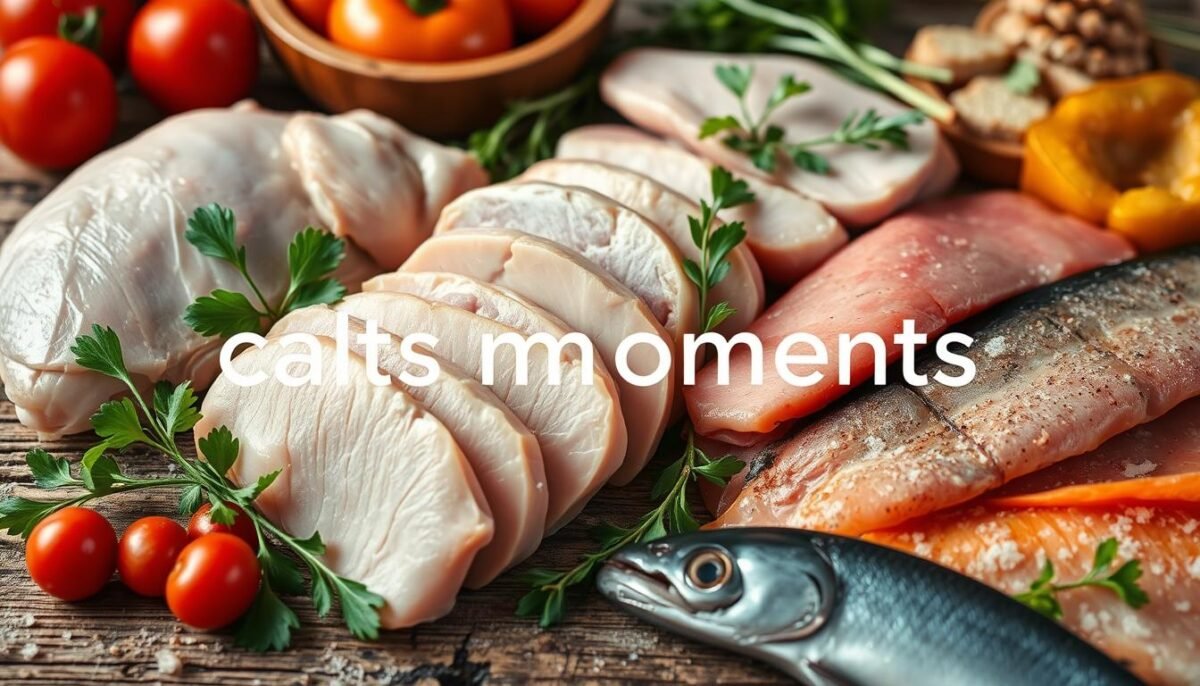
Popular Grain Free Cat Food Formulas
Pet owners are now more aware of their cats’ dietary needs. This has led to a big increase in demand for grain-free cat food. There are many choices, from dry kibble to tasty wet foods, to meet every cat’s taste and nutritional needs.
Dry vs. Wet Grain Free Options
Grain-free cat food comes in dry and wet forms, each with its own benefits. Dry kibble lasts longer, which is great for busy homes. Wet foods, like canned or pouches, have more moisture, helping cats stay hydrated.
Specialized Formulas for Health Issues
Cats with health issues, like food allergies, have special grain-free options. These hypoallergenic foods use new protein sources and avoid common allergens. They offer relief for cats with sensitivities.
Flavor Varieties and Acceptability
It’s important for cats to enjoy their food for a healthy diet. Luckily, there are many flavors available, from chicken to seafood. This variety helps meet even the pickiest cat’s taste buds.
Looking for a dry, wet, or special grain-free food? The market has plenty of choices to keep your cat happy and healthy.
How to Transition Your Cat to Grain Free Diet
Switching your cat to a grain-free diet can be easy and rewarding. Knowing the signs of a good transition, common issues, and helpful tips is key. This ensures your cat’s move to a diet without carbs is smooth and good for their health.
Signs of Successful Transition
Watching your cat’s behavior and health is crucial. Look for signs like:
- More energy and fun during play
- Healthier skin and coat, looking shiny and vibrant
- Less digestive problems, like constipation or diarrhea
- Stable weight and better body shape
Common Challenges and Solutions
Most cats do well on a grain-free diet, but some might face minor issues. Be ready to solve problems like:
- Picky Eating: Start by mixing the new food with the old to ease the change.
- Digestive Upset: Slowly add more of the new food to help your cat’s stomach adjust.
- Transition Stress: Keep a calm, regular routine to make your cat feel secure.
Tips for a Smooth Change
For a smooth transition to a grain-free diet, try these tips:
- Start introducing the new food slowly over 7-10 days
- Offer a variety of high-quality, animal-based proteins to meet your cat’s taste
- Watch your cat’s weight and adjust food amounts to keep them in good shape
- Ask your vet for advice if you’re worried about the diet change
By following these steps and being patient, you can smoothly transition your cat to a grain-free diet. This will improve their nutrition and overall health.
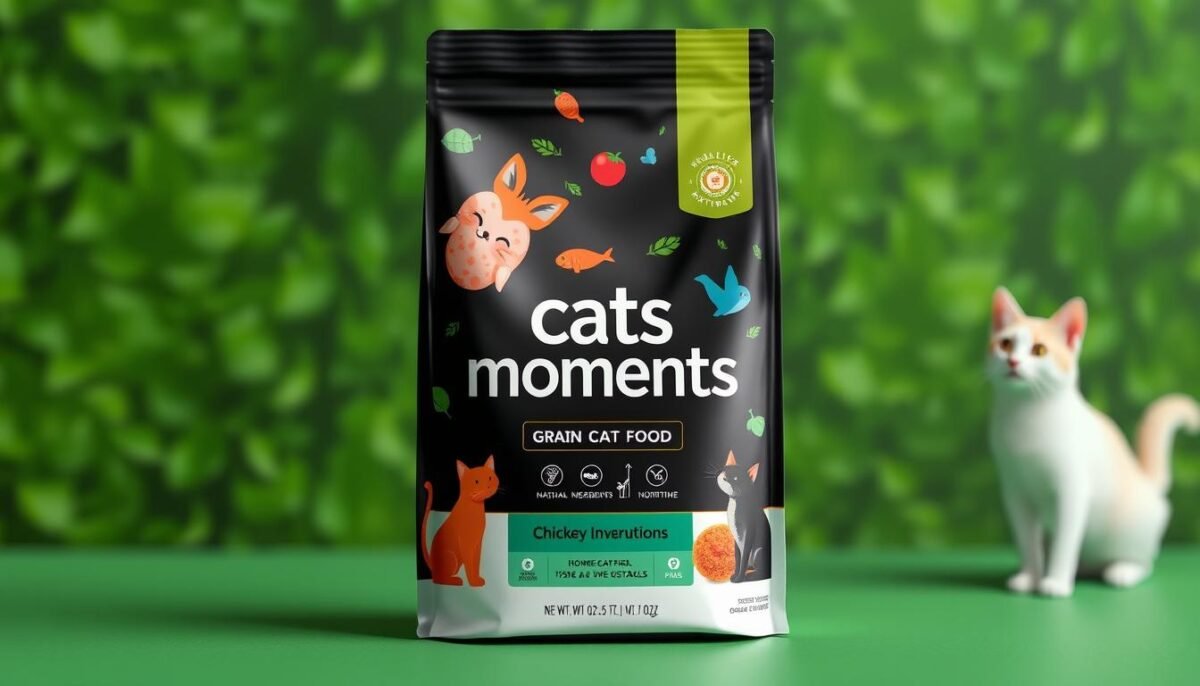
Understanding Labels: What to Look For
When picking grain free cat food, it’s key to know what the labels say. This guide will help you understand ingredient lists, find grain-free certifications, and look at nutritional details. This ensures you choose the best for your cat.
Deciphering Ingredient Lists
Start by checking the ingredient list of grain free cat food. Look for top-notch, grain free proteins like chicken, turkey, or fish. Stay away from fillers or by-products. Also, make sure it has non-GMO ingredients and allergen-free recipes for your cat’s health.
Identifying Grain Free Certification
- Search for third-party certifications that show the product is grain-free, like the “Grain Free” seal or “Certified Grain Free” label.
- These certifications confirm the food is grain-free and meets strict standards.
- They add confidence that the cat food is indeed grain-free.
Nutritional Information to Consider
Look at the nutritional info on the label, focusing on protein, fat, and carbs. Make sure the grain free formula fits your cat’s needs, like their age, activity level, and health.
“Choosing the right grain free cat food is essential for your feline’s overall health and wellbeing. By understanding the label, you can make informed decisions and provide your cat with the best possible nutrition.”
Homemade Grain Free Cat Food: Is It Worth It?
We always want the best for our cats. Homemade grain-free cat food is popular for its nutrition. But is it worth making? Let’s look at the benefits, recipes, and how to keep meals balanced for our cats.
Benefits of Homemade Diets
Making homemade grain-free cat food has many perks. We can pick the best ingredients for our cats. This means they get lots of high-quality animal proteins, healthy fats, and all the nutrients they need.
This is especially good for cats with special diets or allergies.
Recipes for Grain Free Cat Food
Making grain-free cat meals at home is fun. Here are some easy recipes:
- Baked Chicken and Sweet Potato: Shredded cooked chicken, mashed sweet potato, and cat-safe herbs.
- Tuna and Quinoa Bowl: Flaked tuna, cooked quinoa, diced veggies, and fish oil.
- Beef and Vegetable Stew: Ground beef, carrots, green beans, and bone broth.
Nutritional Balance in Homemade Meals
It’s key to get the right nutritional balance in homemade cat food. Cats need specific foods to stay healthy. A bad diet can cause health problems.
Always talk to your vet or a pet nutritionist. They can help make sure your recipes are good for your cat.
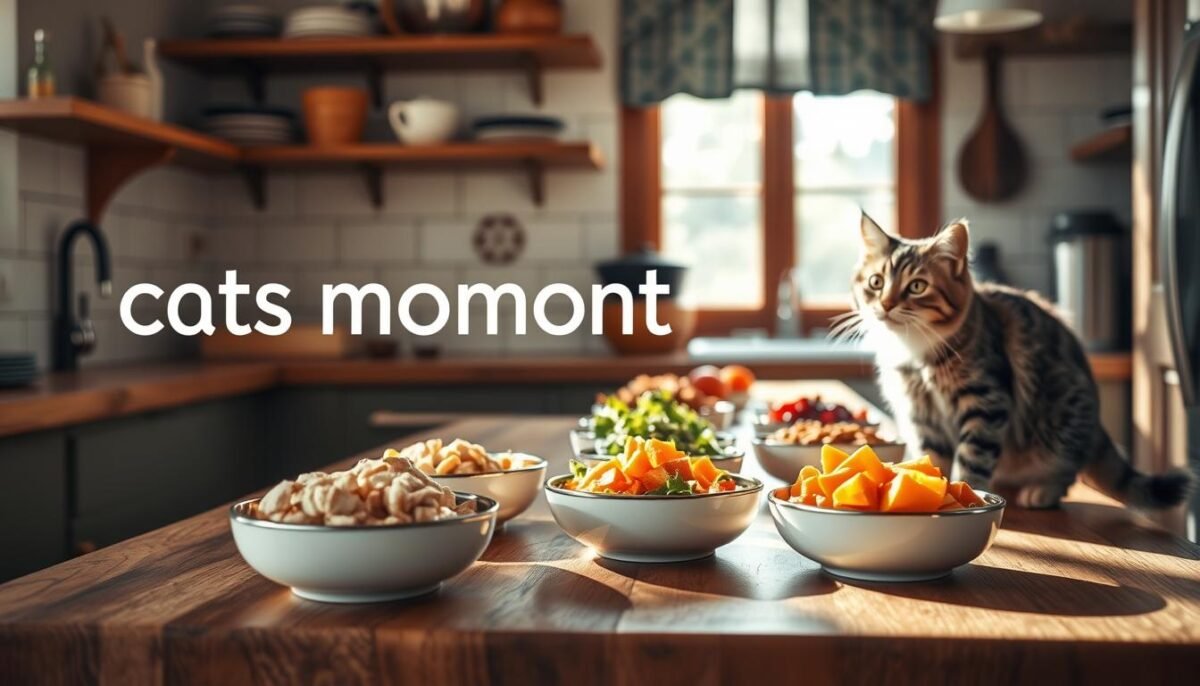
Deciding to make homemade cat food is a big choice. It’s important to think about the good and bad sides. By knowing about feline nutrition, trying tasty high-protein cat meals, and balancing the diet, we can give our cats the best natural cat treats.
Understanding Allergies and Sensitivities
As pet owners, we know how important good nutrition is for our cats. Hypoallergenic pet food helps by avoiding common allergens. Grain-free cat food is great for food sensitivities and overall health.
Common Allergens in Cat Food
Cats can be allergic to many things in pet food, like gluten-free pet products, dairy, beef, chicken, and some grains. These allergies can cause skin problems, stomach issues, and breathing troubles.
How Grain Free Can Help
Choosing grain-free hypoallergenic pet food might solve your cat’s allergy problems. It uses different carbs like potatoes or legumes, which are less likely to cause allergies. This can make your cat feel better and live a better life.
Signs Your Cat May Have Food Sensitivities
- Persistent skin irritation, such as itching, redness, or hot spots
- Chronic gastrointestinal issues, including vomiting, diarrhea, or constipation
- Recurrent ear infections or respiratory problems
- Unexplained weight loss or poor coat condition
If you think your cat has food sensitivities, talk to your vet. They can help find the allergens and create a diet plan. The right hypoallergenic pet food and advice can make your cat healthier and happier.
“By understanding the common allergens in cat food and how grain-free diets can help, we can better support our feline companions and ensure their well-being.”
Tips for Choosing the Right Cat Food
Choosing the right grain free cat food for your cat is important. You need to think about their lifestyle, health, and what they like. This ensures they get the best diet for their needs.
Assessing Your Cat’s Lifestyle and Health
Start by thinking about your cat’s lifestyle and health. Do they run around a lot and need lots of protein? Or are they older and need food that helps their joints? Knowing their age, how active they are, and any health issues helps pick the best feline nutrition.
Consulting with Your Veterinarian
Working with your vet is key when picking grain free cat food. They can tell you what your cat really needs. They know about any allergies and can suggest the best holistic pet nutrition for your cat.
Importance of Trial and Observation
Finding the right grain free cat food might take some time. Watch how your cat reacts to new foods. Look at their energy, coat, and health. Keep trying until you find the food that makes them happy and healthy.
Think about your cat’s lifestyle and health, talk to your vet, and watch how they react to food. This way, you can pick the best nutrition for your cat’s well-being.
Conclusion: Making the Best Choice for Our Cats
Grain-free cat food has many benefits for our cats. It helps with food sensitivities and gives them high-quality protein. These diets can greatly improve our cats’ health and happiness.
Summary of Key Takeaways
Grain-free cat food doesn’t have common grains like corn, wheat, and rice. These grains can cause allergies or stomach problems in some cats. Instead, these foods use premium animal proteins, which cats naturally prefer.
Encouragement to Explore Options
Choosing the right food for our cats is very important. If you want to help your cat’s health or just give them the best food, look into grain-free options. There are many choices out there.
Final Thoughts on Grain Free Cat Food
Deciding to switch to grain-free food should be talked over with your vet. They can help figure out what’s best for your cat. By doing this, you can make sure your cat gets the best nutrition for their health.
FAQ
What is grain free cat food?
Grain-free cat food doesn’t have grains like wheat, corn, or rice. It’s made with animal proteins, fats, and other nutrients. This diet is free from carbs.
Why should I consider a grain free diet for my cat?
Grain-free diets might help cats with allergies or digestive issues. They offer natural nutrients and high-quality proteins. This diet is closer to what cats naturally eat.
What are the essential nutrients cats need in their diet?
Cats need animal proteins, fats, vitamins, and minerals. Taurine is crucial for their health. It should be in their food.
How do I choose the best grain free cat food brand?
Look for brands with animal proteins first. Avoid artificial additives. Choose a brand that uses natural, non-GMO ingredients. Consider your cat’s needs and likes.
What key ingredients should I look for in a grain free cat food?
Good grain-free foods have animal proteins like chicken or fish. They also have healthy fats and fiber sources. These help with digestion.
How do I transition my cat to a grain free diet?
Start with small amounts of grain-free food over 7-10 days. Watch for signs like more energy and better coat. Be patient with any challenges.
Are there any drawbacks to feeding my cat a homemade grain free diet?
Homemade diets need careful planning to ensure all nutrients are included. Always check with a vet or nutritionist to make sure it’s right for your cat.
How can a grain free diet help with food allergies and sensitivities in cats?
Grain-free diets remove common allergens like wheat and corn. This can help with skin issues, digestive problems, and ear infections.
What should I keep in mind when choosing the right grain free cat food?
Think about your cat’s age, health, and activity level. Talk to your vet and read labels. Try different foods to find the best one for your cat.
